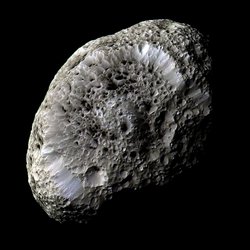
Saturn’s moon Hyperion. Image credit: NASA/JPL/SSI. Click to enlarge.
Cassini performed back-to-back flybys of Saturn moons Tethys and Hyperion last weekend, coming closer than ever before to each of them. Tethys has a scarred, ancient surface, while Hyperion is a strange, spongy-looking body with dark-floored craters that speckle its surface.
New images, mosaics and a movie of these bodies are available at http://saturn.jpl.nasa.gov , http://www.nasa.gov/cassini and http://ciclops.org .
Images of Tethys taken during Cassini’s close approach to the moon on Sept. 24, 2005, reveal an icy land of steep cliffs and craters. Cassini photographed the moon’s south pole, a region not seen by NASA’s Voyager spacecraft.
A giant rift called Ithaca Chasma cuts across the disk of Tethys. Much of the topography in this region, including that of Ithaca Chasma, has been thoroughly hammered by impacts. This appearance suggests that the event that created Ithaca Chasma happened very long ago.
Near a prominent peaked crater named Telemachus are the remnants of a very old crater named Teiresias. The ancient impact site is badly overprinted and eroded by impact weathering and degradation. All that remains is a circular pattern of hummocks that mark where the old crater rim existed. Many of the fresh-appearing craters exhibit unusually bright crater floors, in contrast to the dark-floored craters seen on Saturn’s oddly tumbling moon Hyperion.
Images of Hyperion taken on Sept. 26 show a surface dotted with craters and modified by some process, not yet understood, to create a strange, “spongy” appearance, unlike the surface of any other Saturn moon.
A false-color image of Hyperion reveals crisp details and variations in color across the strange surface that might represent differences in the composition of materials. Hyperion has a notably reddish tint when viewed in natural color.
Scientists are extremely curious to learn what the dark material is that fills many craters on this moon. Features within the dark terrain, including a 200-meter-wide (650-feet) impact crater surrounded by rays and numerous bright-rimmed craters, indicate that the dark material may be only tens of meters thick with brighter material beneath.
Scientists will also be examining Cassini’s sharp views in hopes of determining whether there have been multiple episodes of landslides on Hyperion. Such “downslope” movement is evident in the filling of craters with debris and the near elimination of many craters along the steeper slopes. Answers to these questions may help solve the mystery of why this object has evolved different surface forms from other moons of Saturn.
Cassini flew by Hyperion at a distance of only 500 kilometers (310 miles). Hyperion is 266 kilometers (165 miles) across, has an irregular shape, and spins in a chaotic rotation. Much of its interior is empty space, explaining why scientists call Hyperion a rubble-pile moon. This flyby was Cassini’s only close encounter with Hyperion in the prime mission four-year tour. Over the next few months, scientists will study the data in more detail.
Cassini flew by Tethys at a distance of approximately 1,500 kilometers (930 miles) above the surface. Tethys is 1,071 kilometers (665 miles) across and will be visited again by Cassini in the summer of 2007.
The Cassini-Huygens mission is a cooperative project of NASA, the European Space Agency and the Italian Space Agency. The Jet Propulsion Laboratory, a division of the California Institute of Technology in Pasadena, manages the Cassini-Huygens mission for NASA’s Science Mission Directorate, Washington, D.C. The Cassini orbiter and its two onboard cameras were designed, developed and assembled at JPL. The imaging team is based at the Space Science Institute, Boulder, Colo.
Original Source: NASA/JPL/SSI News Release
